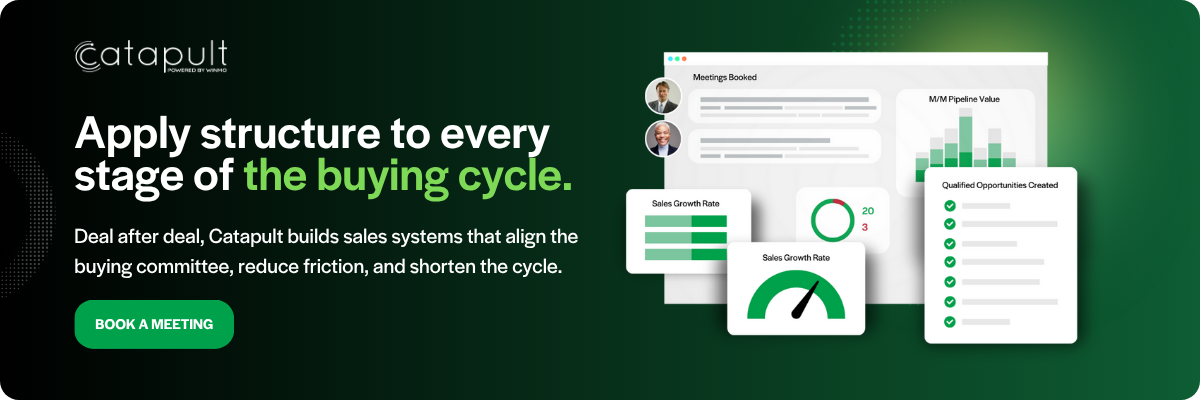TL;DR
- What this blog covers: How to speed up B2B sales cycles by mapping and engaging the full buying committee. Learn how to surface decision-makers early, align messaging by role, and keep deals moving.
- Why it matters: Enterprise deals aren’t stalling because of weak outreach. They’re stalling because too many stakeholders get involved too late, and most teams aren’t managing that complexity.
- What you’ll walk away with: A clear plan to identify key stakeholders, understand what each one needs, and build momentum across departments.
- What’s included: Four proven tactics for stakeholder mapping, role-specific content, mutual action plans, and multichannel outreach.
- Who it’s for: Growth leaders at agencies, media companies, adtech platforms, and sponsorship firms managing long sales cycles and multi-decision-maker deals.
Enterprise sales cycles keep getting longer. You’re facing more stakeholders, more approvals, and more moving parts in every deal. In fact, over the last three years, the average number of stakeholders involved in a B2B buying decision has climbed from 6.8 to 8.5. This increase alone has extended average sales cycles by 22%.
If you’re managing growth for an agency, media company, sponsorship seller, or adtech platform, you’ve likely seen it firsthand. Conversations that felt promising lose steam. New priorities pop up mid-funnel. The person you’re aligned with internally doesn’t have final say, and the real decision-maker isn’t even in the room.
In this guide, you’ll learn how to map, engage, and align your full buying committee, so you can shorten your B2B sales cycle and close more consistently.
What’s Really Slowing Your Sales Cycle?
You’re doing the outreach. You’ve got the right contacts. The initial conversations are solid. But then the timeline drags. Why? Because enterprise buying decisions aren’t made by one person anymore. If you’re not actively mapping who’s involved and what each person needs to say yes, you’re leaving the pace of the deal to chance.
Here’s what’s likely slowing you down:
1. Too many stakeholders, too little clarity
Enterprise sales used to mean managing a few key relationships. Now, you’re navigating a crowd including:
- Finance: Focused on cost control
- Procurement: Ensuring compliance
- Legal: Flagging contract language
- Strategy: Checking for business alignment
- IT: Evaluating security and integration
- Marketing: Caring about campaign lift
Each stakeholder introduces new objections, timelines, and internal roadblocks. Without a clear plan to engage them early, deals stall.
2. Generic messaging that slows decisions
When your pitch speaks to everyone, it lands with no one. Enterprise champions should not have to translate your value prop across departments but that’s exactly what happens without tailored messaging.
If your content doesn’t speak directly to each stakeholder’s priorities:
- Your champion ends up selling internally without support
- Decision timelines stretch
- The deal risks dying in committee
Top-performing teams avoid this trap. They take a structured approach to account planning and stakeholder engagement. The results speak for themselves:
- 91% of companies using account-based strategies and stakeholder mapping see increased deal size
- 25% report growth over 50%
4 Proven Tactics to Get the Buying Committee Aligned and Deals Moving
Deals move faster when there’s structure behind them. Long sales cycles are usually a sign that key stakeholders weren’t identified early, the message missed the mark, or internal teams never got fully aligned.
The steps below are built to correct that. They bring clarity to the process, build momentum across departments, and keep deals progressing.
1. Map the full buying committee before outreach begins
If you don’t know who’s involved, you can’t control the pace or direction of the deal.
Stakeholder mapping gives your team a clear line of sight into decision-makers, influencers, blockers, and approvers. It anchors your outreach strategy in real organizational structure instead of job titles pulled from LinkedIn. This step brings clarity to what would otherwise be guesswork.
Build your map with these four steps:
- Map the stakeholder landscape: Identify champions, decision-makers, blockers, and influencers early. Understanding who’s in the room (and what role they play) sets the foundation for a faster, more strategic sales cycle. Firms that map the buying committee at the top of the funnel reduce time-to-close by 20–30%. When everyone is accounted for early, deals stay on track.
- Gauge influence and ownership: Assign influence levels and tie each stakeholder to their departmental priorities. This helps you anticipate objections and customize your pitch to what matters most to each voice in the deal.
- Centralize insights with tools that scale: Use your CRM and research platforms to track roles, relationships, and buying triggers. Consistent documentation keeps your team aligned and ensures no critical influence is overlooked.
- Tailor outreach by function: Align your messaging and cadence to each stakeholder’s role. Legal doesn’t care about performance metrics, and marketing isn’t worried about compliance. Meet each stakeholder where they are to keep momentum.
2. Use Mutual Action Plans to build internal momentum
Many deals stall because the buying committee loses alignment. When four or more departments need to weigh in, a clear plan becomes a non-negotiable.
A Mutual Action Plan (MAP) creates that clarity. It turns sales conversations into structured next steps, supported by both sides.
A strong MAP includes:
- Key milestones and target dates
- Assigned responsibilities across both buyer and seller teams
- Internal review checkpoints for legal, finance, or IT
- Shared close criteria to define success
Sales teams that implement MAPs typically shorten their cycles by up to 20%. That time savings compounds across quarters and reduces risk in every forecast. MAPs are especially useful when navigating RFPs, complex service agreements, or enterprise marketing partnerships.
3. Tailor content to each role in the buying committee
Stakeholders interpret value differently. Finance, marketing, legal, and procurement don’t speak the same language, so they shouldn’t be given the same content.
Match your content to what each person actually needs to evaluate the deal.
Stakeholder | What they need to see |
Finance | ROI models, budget impact, payment terms |
Marketing | Case studies, brand alignment, performance KPIs |
Procurement | Vendor approval docs, risk and compliance summaries |
Strategy | Business case alignment, organizational relevance |
IT / Legal | Integration specs, security documentation, terms |
This alignment ensures operational efficiency. You remove friction, reduce internal handoffs, and give your champion the tools to push the deal forward.
4. Drive buying committee engagement with multichannel outreach
A mapped buying committee is only useful if your message actually reaches them. In complex B2B sales cycles, outreach needs to be built for how enterprise teams operate: cross-functional, distributed, and asynchronous. Multichannel communication ensures you’re meeting decision-makers where they are, not hoping a single-threaded email finds its way around the org.
An effective multichannel outreach strategy includes:
- Coordinate outreach across channels: Engage prospects through email, phone, and LinkedIn to increase visibility and stay top of mind across multiple touchpoints.
- Sequence cadences with intent: Structure your outreach to reflect stakeholder hierarchy and deal urgency, ensuring the right message hits at the right time.
- Deploy role-specific content: Share tailored content based on each stakeholder’s job function and where they are in the buying journey to drive relevance and action.
- Track engagement to prioritize follow-up: Use activity data to surface high-intent contacts so your team can focus on the prospects most likely to convert.
This approach reduces reliance on one internal contact and prevents your message from getting stuck in siloed conversations. It also helps surface previously invisible members of the B2B buying committee (those who influence from the side but still shape the final call).
Build a Sales System That Scales Across Every B2B Buying Committee
A mapped buying committee and role-specific outreach will improve individual deals, but scaling that across your pipeline takes infrastructure. You need systems that remove guesswork, prioritize real movement, and keep complex sales aligned from first contact to close.
This is where teams start to shorten the sales cycle consistently, not just occasionally.
1. Identify stakeholders faster
Speed starts with visibility. The sooner you know who’s involved, the sooner you can tailor outreach, spot blockers, and align the message.
- Surface likely roles with the right tools: Your tech stack matters. Use platforms like Winmo, LinkedIn Sales Navigator, and org-mapping software to identify key players before outreach even begins.
- Analyze past wins for stakeholder patterns: Review closed-won deals to spot trends in stakeholder involvement by vertical, deal size, or company type.
- Equip reps to lead discovery conversations: Train your team to ask direct, early questions about the buying committee so they can map influence faster and avoid mid-funnel surprises.
This early clarity removes delays downstream and improves win rates across enterprise deals.
2. Prioritize momentum, not motion
Progress happens when buyer-side engagement is present and measurable. To focus your team’s effort where it counts, use these cues to identify which opportunities deserve time and attention:
- Prioritize multi-threaded deals with real signals: Focus your time on accounts where multiple stakeholders are engaging. That’s where momentum lives.
- Deprioritize stalled, single-threaded leads: If there’s no cross-department movement, it’s a signal to pause or redirect efforts.
- Shift focus to urgency, not activity: Target accounts showing buyer-side urgency instead of just racking up outreach volume. Quality beats quantity every time.
Long sales cycles shrink when attention is focused on deals with real alignment.
3. Let content performance guide follow-ups
Outreach works better when content data leads the way.
- Track engagement signals that matter: Monitor who’s opening, clicking, forwarding, and revisiting assets to surface intent and prioritize outreach.
- Sequence follow-ups based on behavior: Use title-specific engagement to time your next steps and guide stakeholders through the buying process more effectively.
- Refine messaging with performance data: Analyze real engagement trends by role — especially across finance, marketing, and procurement — to sharpen your narrative and improve conversion.
This turns content from static collateral into an active part of your sales system.
4. Engage the full buying committee (on purpose)
Enterprise deals slow down when you rely on one internal advocate. Sales velocity increases when you build momentum across the committee.
- Run coordinated outreach in parallel: Engage multiple stakeholders at once to build momentum and avoid bottlenecks tied to a single contact.
- Use multichannel cadences for visibility: Combine email, phone, and social to create internal alignment and keep your message circulating across departments.
- Re-engage inactive contacts with fresh angles: Tailor new outreach to each stakeholder’s priorities to revive interest and bring them back into the conversation.
This approach shortens sales cycles by reducing internal confusion and preventing last-minute surprises.
Conclusion: Stakeholder alignment is the shortcut
B2B sales cycles aren’t long because buyers don’t want to buy. They’re long because internal alignment takes work and most sellers don’t manage it.
When you map the buying committee, build structure into your process, and deliver message clarity at every stage, deals move.
Catapult partners with agencies, media companies, sponsorship sellers, and adtech and martech platforms to build sales engines that perform in complex, multi-stakeholder environments. If you’re tired of guessing what’s slowing your pipeline down, we’ll help you build a process that makes deal movement predictable.
You own growth. We help you shorten the cycle and close the right work. Book a meeting here.
FAQ
A buying committee includes all the individuals involved in evaluating, influencing, or approving a purchase decision. This typically includes stakeholders across departments like marketing, procurement, finance, strategy, and IT.
Each stakeholder brings different priorities, decision criteria, and internal processes. Without clear alignment, decisions get delayed as teams try to reconcile competing needs.
Start by identifying your initial contact’s role and likely collaborators. Use discovery calls, CRM tools, and research platforms to track titles, influence levels, and departmental ownership.
When each stakeholder sees the information that matters to them, internal conversations happen faster. Tailored content supports buy-in and reduces objections before they gain traction.




